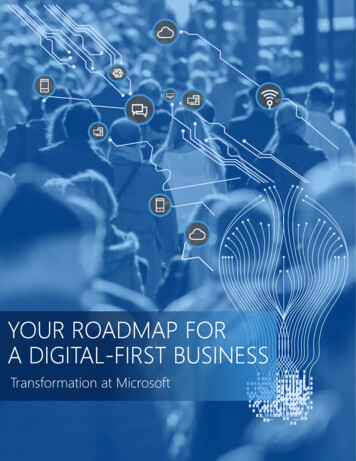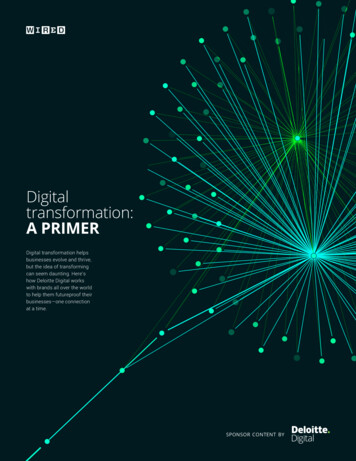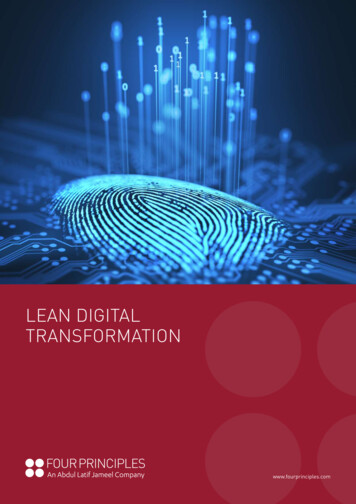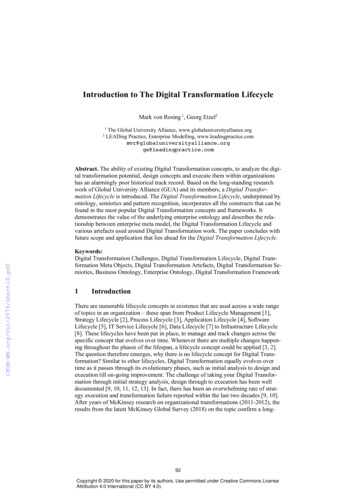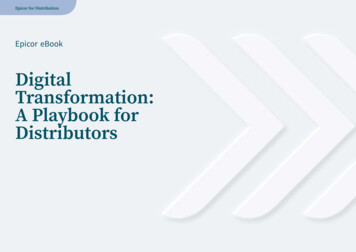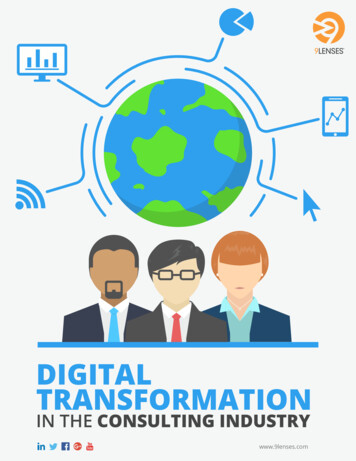
Transcription
DIGITALTRANSFORMATIONIN THE CONSULTING INDUSTRYwww.9lenses.com
DIGITAL TRANSFORMATION INCONSULTING9LENSES CONSULTING INDUSTRY ANALYSISThe second annual installment of “Digital Transformation in the Consulting Industry” is beingconducted by 9Lenses to provide consultants with the data to assess their performance andbenchmark against peers. The analysis is broken down into four components:1 Digital Overview2 People3 Process4 Data ManagementThis analysis was conducted using the 9Lenses digital diagnostic platform, and the accompanying report was produced using our platform analytics. To learn more about how 9Lensescan transform your consulting diagnostics, please visit our website at www.9lenses.com orrequest a demo from our team.We hope you will find a wealth of new ideas, validate existing thinking and build for the future of your practice.The 9Lenses Team29Lenses, The Digital Diagnostic Platform
THE OCCASION FOR THE RESEARCH:DIGITAL TRANSFORMATION“DIGITALLY TRANSFORMED ORGANIZATIONS PERFORMEDMUCH BETTER THAN ORGANIZATIONS THAT LAGGED BEHIND,EFFECTIVELY CREATING A “DIGITAL DIVIDE” ACROSS COMPANIES”-Harvard Business ReviewLast year, we discussed the prevalence of digitalBeing digital matters. With a few years of digitaltransformation buzz in the market. The term itselftransformation experiences under our collectivewas a top performer on Google Trends in 2016 andbelts, we’ve been able to assess the impact thesenow into 2017. Consultancies were quick to movechanges have made. HBR found that digital leaderson the opportunities the buzz created. Source Glob-outperform laggards significantly. What separatedal Research estimates the digital transformation con-leaders was their ability to use data in customer ex-sulting market at over 23B. This is nearly 20% ofperience, product design, service delivery and em-all consulting services offered. In addition, our diag-ployee performance. If we were to assess the con-nostic found 78% of respondents are offering dig-sulting industry’s performance on the criteria thatital transformation services, up from 74% in 2016.HBR outlined for digital leaders, would it pass? DoIs this a short-term revenue trend or a substantiveconsulting firms use digital platforms for custom-shift in the way consultants do business?er experience, product design, service delivery andemployee performance?This year we’re determined to learn if consultingfirms are adopting the digital approach they es-We’ve set out to answer these questions in our analysis.pouse to clients.DIGITAL LEADERS OUTPERFORM LAGGARDS ON THREE FINANCIAL MEASURESBased on 2012-2014 data from 344 enterprises listed on U.S. exchanges.Digital Leaders (top 25% of companies)Digital Laggards (bottom 25% of companies)3-YEAR AVERAGE GROSS MARGIN55%37%3-YEAR AVERAGE OPERATING MARGIN18103-YEAR AVERAGE PROFIT MARGIN117SOURCE: S&P CAPITAL IQ, KEYSTONE STRATEGY ANALYSIS39Lenses, The Digital Diagnostic Platform
THE OCCASION FOR THE RESEARCH:DIGITAL TRANSFORMATIONDuring our analysis, it was clear that the specter of the new digital economy created a number of new questions that should be taken seriously. Are we making the appropriate changes to our operations and culture? Should we begin to rethink the billable hour business model? If our strongest assets are our people and our IP, are we scaling them? Are we testing new models to deliver value to clients? Are we beginning to invest in digital tools for a future in which ourclients will be entirely digital?We can’t answer all of these questions yet. But we do know from working with our customerson the 9Lenses platform that leading firms are already testing ALL of these ideas.Our sincere hope is that the analysis in the following pages will help inform forward-thinkingconsulting leaders. It will be by testing new ideas and evolving business models that leaderscan get ahead of a digital future dominated by data.49Lenses, The Digital Diagnostic Platform
DIAGNOSTIC ANALYTICS96 Participants56.25% User Comment Rate3,216 Data Points82.29% User Comment Ratio14:26 Average Time to Complete216 CommentsDEMOGRAPHICSPractice AreaCompany Size1,000 Employees 3641.6%37.5%Partner 5658.3%501-1,000Employees 44.2%Associate 33.1%Strategy 3536.5%EngagementManager 21AssociatePartner 124.2%12.5%25%21.9%51-100Employees 4101-500Employees 12DigitalTransformation 24Role1-50Employees 4012.5%HumanResources 1212.5%Finance 11%InformationOther 10Technology 1010.4% Supply Chain10.4%/Ops 44.2%Analyst 44.2%RESPONDENT FEEDBACKWe’ve summarized respondent feedback so thatwhether the increased ask from our respondentswe can continue to refine the quality of our ques-was worth the insight we collected, or perhaps wetions. At the end of the diagnostic we asked users tocan trim time in future iterations. One idea is torank the quality of the experience on 5 point scaleeliminate the definition of digital transformationand our average ranking was a 3.67 out 5. Certainlyand ask respondents to force rank which categorysome work to be done!they believe provides the most benefit to clients.One of our goals this year was to increase the insightand data points from our diagnostic to improve thequality of our output without substantially impact-Incidentally, our software rated a 4.33 out of 5. Weuse this feedback to continue to refine our productand identify potential trouble spots.ing response rates or completion rate. This yearEach 9Lenses diagnostic includes an opportunity forwe had 96 full participants vs. 93 last year but wererespondents to provide feedback into the questionsable to improve the number of data points collectedthemselves. Our clients use this data and our diag-from 2,112 to 3,216, a 52% increase! We increasednostic analytics to tweak or eliminate questions, findthe number of comments from 126 to 216, a 71%the appropriate segments and gather feedback thatincrease, while our comment rate improved frommight not otherwise be provided. The net result is45.16% to 56.25%. One note we’re making for nextthat the platform aids consultants in the quality andyear is that the average completion time increasedscience of their questions over time.from 9:48 to 14:26 minutes. We’ll have to weigh59Lenses, The Digital Diagnostic Platform
EXECUTIVE SUMMARYDIGITAL TRANSFORMATION WILL SHAPE THE BUSINESS WORLD,BUT THE DIGITAL MATURITY OF CONSULTANTS REMAINS LOWTools and TechnologyHow would you rate your firm's digital maturity?100%80%60%1-50 Employees1,000 Employees101-500 Employees501-1,000 Employees51-100 Employees40%20%0%To what degree has adigital approach enabled youto win more business?To what degree do you seedigital transformation shaping thebusiness climate in the next 5 years?It’s not if digital transformation will impact your business, but when. Ninety-four percent ofrespondents indicated that digital transformation will have an extreme or near extreme impact to the businessworld in the next five years. This year, senior managers of consulting firms are championing the transformationof their firms. 62% of respondents felt senior management is promoting a digital approach to an extreme ornearly extreme degree. This is a large change from last year, when senior management was a significant hurdleto a digital approach. Consulting leaders are recognizing the need for a more digital approach both so that theyare credible service providers and so they can realize the benefits they are providing to clients.Transformation presents opportunity. Firms that view transformation as an opportunity will have morebusiness available and be better positioned for growth in the future. In the short term, the digital transformationconsulting market is, according to Source Global Research, already valued at 23B, nearly 20% of the total market.According to our research, 78% of respondents are offering those services to clients, an increase over last year.Longer term, the most forward-thinking firms are already testing new models for delivering value to clients andidentifying new adjacent revenue streams.Consulting firms have a long way to go in their own transformation. The changes that firms aremaking in response to digital opportunity are still largely surface level. Changes to value proposition and the consulting portfolio were the most selected changes. In addition, respondents self-rated their firm’s digital maturitywith modest scores and further indicated that digital capabilities are only somewhat ingrained in company culture. If firms are to truly digitally transform their business, it will be through transforming culture that they do it.Digital transformation will impact every practice area. The results make clear that the impacts ofdigital transformation will not be confined to a single practice or functional area. Respondents, when definingdigital transformation, believe the impact to day-to-day activities is real and has impacts across the business forinnovation, customer experience, how data is connected and how decisions are made.69Lenses, The Digital Diagnostic Platform
DIGITAL TRANSFORMATIONIN YOUR OWN WORDSWe offered an open-ended question asking respondents to define digital transformation in their own words.The responses varied in depth, description and direction. To help make sense of the data, we used our commentsorting technology to quantify the definitions according to the benefit provided. We also selected a few of thedefinitions that we felt were powerful and articulate.Two areas stood out in the analysis of how digital transformation was defined.1.It’s clear digital transformation is not limited to a single practice or functional area. The definitions and theirbenefits span across industries, business models, customers, employees and decision making.2.Our definitions still have a long way to go for clear, benefit-focused articulation. Many firms and practiceswould benefit from a few small working sessions to collect knowledge on the subject and have each consultant practice articulating the benefits as they would with a client.To learn more about how top firms are defining digital transformation, 9Lenses researched publicly availableinformation and compiled those definitions in one place.Benefits of Digital Transformation: Comments Quantified5Operational GainsConnectivity/Communication154AutomationBetter DecisionMaking/Use of Data13Improved CustomerExperience22EmployeeEfficiency Gains5Business 079Lenses, The Digital Diagnostic Platform
DIGITAL TRANSFORMATIONIN YOUR OWN INESSMODELSINTOMULTIFACETED GROWTH ENGINES USING MOBILITY, BIG DATA, SOCIAL MEDIA, CLOUDCOMPUTING, AND ROBOTICS SO THAT IT STAYS CONTINUOUSLY RELEVANT TO USER’S ORCUSTOMERS IN A ERA OF EXPONENTIAL CHANGE.THE USE OF DIGITAL TECHNOLOGIES AND DATA TO CREATE NEW VALUE PROPOSITIONS ANDOPERATING MODELS. THESE ARE ENABLED BY DIGITAL INNOVATION AND CREATIVITY TOADDRESS NEW DIGITAL USAGES, BEHAVIORS AND NEEDS, RATHER THAN ENHANCING ANDSUPPORTING TRADITIONAL METHODS.THE USE OF TECHNOLOGY TO RADICALLY IMPROVE THE PERFORMANCE OR GROWTH OFENTERPRISES.DIGITAL TRANSFORMATION IS BEST DEFINED AS INVESTMENTS MADE BY ORGANIZATIONS IN,TECHNOLOGY, BUSINESS MODELS, AND PROCESSES THAT DRIVE NEW VALUE FOR CUSTOMERSAND EMPLOYEES ALLOWING THEM TO MORE EFFECTIVELY COMPETE IN AN EVER-CHANGINGDIGITAL ECONOMY.DIGITAL TRANSFORMATION IS ABOUT HELPING ORGANIZATIONS CHANGE TO ADOPT ANDTHRIVE WITH THE WAY WORK IS CHANGING: WITH MORE RELIANCE AND INTEGRATION WITHTECHNOLOGY, MORE AUTOMATION, MORE EMPOWERED AND FLEXIBLE HUMAN RESOURCESAND HIGHER EXPECTATIONS FROM CUSTOMERS AND TEAM MEMBERS.LEVERAGING DIGITAL TECHNOLOGY IN AN ORGANIZATION TO OPERATE MORE EFFECTIVELYAND EFFICIENTLY - BOTH INTERNALLY AS WELL AS IN PROVIDING PRODUCTS AND SERVICES TOCLIENTS AND CUSTOMERS.DIGITAL TRANSFORMATION IS BEST DEFINED AS INVESTMENTS MADE BY ORGANIZATIONS IN,TECHNOLOGY, BUSINESS MODELS, AND PROCESSES THAT DRIVE NEW VALUE FOR CUSTOMERSAND EMPLOYEES ALLOWING THEM TO MORE EFFECTIVELY COMPETE IN AN EVER-CHANGINGDIGITAL ECONOMY.89Lenses, The Digital Diagnostic Platform
DIGITAL OVERVIEWASSESS THE DEGREE TO WHICH YOU FEEL THE MARKET ISTRANSFORMING DIGITALLY AND HOW YOUR FIRM IS RESPONDINGTo what degree do you see digital transformation shapingthe business climate in the next 5 years?264Rank By Participants1-50 Employees51-100 Employees101-500 Employees501-1,000 Employees1,000 Employees64Extremely: 53Somewhat: 32Not At All: 13NIL0510152025303540Number of Participants45505560657094% of respondents indicated digital transformation will have an extreme or nearly extreme impact on the business climate in the next 5 years, an increase of 10% from last year.Does your firm offer consulting services to assist clients’ digital transformation?2017801-50 Employees51-100 Employees101-500 Employees501-1,000 Employees1,000 Employees75 78%20167068 74%Number of Participants60504030201624 26%20201716 17%2017103 3%0YesNoUnsurePoll OptionsThe majority of respondents, 78%, are offering digital transformation services to their clients, an increase fromlast year’s 74%.99Lenses, The Digital Diagnostic Platform
DIGITAL OVERVIEWWhich of these changes has your firm made in the last 3years in response to digital trends?1-50 Employees51-100 Employees101-500 Employees501-1,000 Employees1,000 Employees802017Number of 16433939302017312017242016201620131210201782016 2017540Made significantchanges to ourconsultingportfolioMade changes toour valueproposition orpositioning in themarketAcquiredcompanies to adddigital capabilitiesto our internalprocess orexternal offeringHired morepeople withdigital capabilitiesin our practiceareaUndertookdigitizationtraining formy employeesor meWe have notmade any ofthese changesOtherPoll OptionsMuch like last year, the most frequently cited change to digital trends has been in the form of value propositionand positioning in the market, followed by changes to consulting portfolio. More substantive changes to acquirecapabilities, skills or people have lagged. However, 2017 saw an increase in acquisitions and an increase in thosefirms hiring more people with digital capabilities.Please rank the most important objectives for your practice or business100%41290%429162880%Priority 1Priority 2Priority ntiating OurOffering to WinNew BusinessGetting to ResultsQuickly so ClientsSee Value SoonerInvesting in NewTools or Methodsto Fund FutureGrowthAttracting andDeveloping TopTalent to Join OurFirmMaintainingRelationships toIncrease BillableHoursDifferentiating business offerings and winning new business was the highest rated priority. Getting to resultsquickly ranked second, while investing in tools for future growth came in third. Consultants are prioritizing making money, quickly. Perhaps a warning that longer-term investments in tools and people is not an area of focus.Incidentally, our customers tell us the best way to “stay sticky” with clients is to ground that relationship in data.109Lenses, The Digital Diagnostic Platform
DIGITAL OVERVIEWHow would you rate your firm’s digital maturity?304Rank By Participants1-50 Employees51-100 Employees101-500 Employees501-1,000 Employees1,000 Employees9Extremely Digital : 536Somewhat Digital : 3172Not At All Digital : 12NIL20246810121416182022Number of Participants242628303234363852% of respondents indicated that they’re only somewhat digital to not at all.To what degree has a digital approach enabled you to win more business?We're Wining Because:5We're Digital304Rank By Participants1-50 Employees51-100 Employees101-500 Employees501-1,000 Employees1,000 Employees1236Helps Somewhat : 3925It Does Not Help : 14NIL05101520Number of Participants25303540Similarly, the majority of respondents, 57%, indicated that a digital approach has only somewhat or not at allenabled them to win more business.Consultants are telling us how important digital transformation is to the business environment, but as an industry consultants are lagging behind in their maturity and ability to monetize that approach.119Lenses, The Digital Diagnostic Platform
PEOPLEASSESS THE DEGREE TO WHICH CULTURE AND PEOPLE ARE IMPACTEDBY DIGITAL TRANSFORMATION AT YOUR FIRM OR PRACTICETo what degree is the senior management of your firm promoting a digital approach?274Rank By Participants1-50 Employees51-100 Employees101-500 Employees501-1,000 Employees1,000 Employees33Extremely : 523Somewhat : 3823Not At All : 12NIL024681012141618202224262830323436Number of ParticipantsAs we noted in the executive summary, senior management buy-in to a digital approach is no longer a challenge.In fact, we found that 62% of respondents felt senior management is promoting a digital approach to an extremeor nearly extreme degree.To what extent are digital capabilities ingrained in your company culture?264Rank By Participants1-50 Employees51-100 Employees101-500 Employees501-1,000 Employees1,000 Employees8Extremely : 533Somewhat : 32027Not At All : 12NIL0246810121416182022Number of Participants24262830323436Although senior management is on board, digital capabilities are yet to be ingrained in company culture. 65% ofrespondents believe it’s only somewhat or not at all ingrained in the culture.129Lenses, The Digital Diagnostic Platform
PEOPLETo what degree does your firm or practice offer the following digitaltransformation resources for EMPLOYEES?3.61Training3.53Invest in Digital3.41Cultural Changes3.65CollaborationBusinessDevelopment Support3.8401 : Not At All23 : Somewhat45 : ExtremelyScoreWhen asked about what resources firms were supplying to employees, thought leadership and business development resources, both used to secure new business, came out ahead.What changes would you like to see at your firm to better enable employees?29Training22Invest in Digital12Cultural Changes6CollaborationBusinessDevelopment Support4024681012141618202224262830We asked respondents to comment on what changes they would like to see from their firms to better enableemployees, and the results were quite clear across the board. Using our comment sorting technology, we quantified the responses into five different categories. Training and digital capability investment were the top areas.Training in particular seemed to be the root issues in cultural changes and business development support.139Lenses, The Digital Diagnostic Platform
PEOPLEWhat skills and competencies do you value most in hiring and promoting employees?100%90%69151480%9Priority 1Priority 2Priority roblem Solving/Analytical SkillsCollaboration/Working in TeamsAdaptabilityEmotionalIntelligenceComfort withAmbiguityDigital/TechnicalExpertiseWe were curious if consultants changed their perceptions of desired skills for employees in response to digital trends. But the results were clear that analytical and problem-solving skills are valued above all else, whileteamwork and adaptability were rated second and third. Consultants continue to seek those able to help solvechallenging problems while working well in teams.It’s clear from our “people” section that managers are for digital transformation, the resources are there andfirms are hiring the right skills. However, no one seems to be taking ownership for leading the digital charge forinvestments and training.149Lenses, The Digital Diagnostic Platform
PROCESSRank By ParticipantsTo what degree is moving to a digital consulting process a priority foryour practice/company (e.g. Not using spreadsheets, surveys)?Extremely : 5294291-50 Employees51-100 Employees101-500 Employees501-1,000 Employees1,000 Employees18Somewhat : 31027Not At All : 13NIL02468101214161820222426283032Number of Participants60% of respondents indicated that a digital consulting process is an extreme or nearly extreme priority for theirfirm or practice.How much time do you spend collecting and organizingclient data for presentation in a single engagement?20174541 43%402016Number of Participants352016201729 30%28 30%3032 34%20162522 24%2015201712 12%9 10%20170201620171051-50 Employees51-100 Employees101-500 Employees501-1,000 Employees1,000 Employees20169 9%3 3%1 1% 2 hours2-10 hours11-15 hours16-20 hours 20 hoursPoll Options64% of respondents are spending 11 hours collecting and organizing client data for a presentation in a single engagement. That’s a significant amount of non-value-adding activity that could be automated with the right platform.159Lenses, The Digital Diagnostic Platform
PROCESSHow long does your discovery process typically take?601-50 Employees51-100 Employees101-500 Employees501-1,000 Employees1,000 Employees201657 62%2017504030201720162020 22%22 23%2017201610201720179 9%7 8%10 10%8 8%20163 3%201620162 2%1 1%0 2 weeks2-4 weeks5-6 weeks7-8 weeks 8 weeksOtherPoll Options70% of respondents spend less than 4 weeks in discovery time. A commendable improvement as clients seek valuefaster and less time identifying business issues.Are individuals or practices able to leverage consultingframeworks or data from other teams?50201640201740 44%39 41%201638 42%Number of ParticipantsNumber of Participants45 47%201737 38%1-50 Employees51-100 Employees101-500 Employees501-1,000 Employees1,000 Employees30201720201616 17%13 14%100Yes, we have a system to collaborateon existing and past assessmentsNo, assessments typically staywithin the same teamSometimes, we have ad hocsharing between teamsPoll Options41% of respondents indicated they are able to leverage the frameworks and data from other teams. A worrying54% are not able to leverage data from their peers or are only able to on an ad hoc basis. We’ve found that siloedframeworks and data create redundancies and prevent firms from building on their knowledge of the issues theysolve and their clients.169Lenses, The Digital Diagnostic Platform
PROCESSWhich of the following are challenges you face in taking your consulting process digital?501-50 Employees51-100 Employees101-500 Employees501-1,000 Employees1,000 Employees201645Number of 272016201820172017201615152016159100Lack of technologyinfrastructure andIT systemsDifficulty infinding technicaltalentLack of seniormanagementinterest or desireto changeLack of qualitydata fordigitizationWe’re good to go,no real challengesto going digitalWe’re still trying tounderstand what goingdigital meansOtherPoll OptionsRespondents indicated that the biggest challenges to taking their consulting process digital are lack of IT systemsand lack of quality data. 33% of respondents are still trying to understand what going digital means for their firms.This is a trend we continue to see in the market as digital transformation takes on many facets. Also noteworthy isthe fact that lack of senior management interest or desire to change is decreasing year over year.In our process section, consultants have indicated that a digital approach is a priority but are still spending too muchtime identifying issues, collecting data and even recreating the wheel. While different firms have different challenges, a disconnect still exists between desired and current state, perhaps pointing back to an ownership issue.179Lenses, The Digital Diagnostic Platform
DATA MANAGEMENTASSESS THE DIGITAL DATA MANAGEMENT CAPABILITIES OF YOUR FIRMOR PRACTICEDoes your firm have clearly defined IP (i.e., frameworks, methodology, assessments)?601-50 Employees51-100 Employees101-500 Employees501-1,000 Employees1,000 Employees51 53%Number of Participants504032 33%302011 11%100YesNoSomewhatPoll OptionsHow effective is your firm at generating revenue from your IP?Extremely : 54Rank By Participants1-50 Employees51-100 Employees101-500 Employees501-1,000 Employees1,000 Employees1027Somewhat : 325221Not At All : 110NIL3024681012141618202224262830Number of ParticipantsIn our data management section, we included questions about intellectual property, or IP, as many consultantshave told us that this knowledge lives with individual consultants and is at risk when employees leave the firm.Further, we found many consultants told us that much of their firm’s knowledge is underutilized and not effectively monetized.The results supported our anecdotal evidence. 52% of respondents indicated their firm has defined IP. Whenasked how effective their firm is at generating revenue from IP, we found most responses, 76%, were somewhatable to in the 2-4 range. Clearly there is a disconnect between consultant knowledge and the ability to win business with that knowledge. What is preventing firms from making money from their IP?189Lenses, The Digital Diagnostic Platform
DATA MANAGEMENTHow much of your firm’s assessments, frameworksand IP are currently stored in the following ways?27.9%Excel or spreadsheets onindividual hard drives32.3%Company intranet/connected storage35.54%Password-protectedcloud 38Rank by %27% of that data is stored in ways that cannot be effectively leveraged across practice areas or the employee base.Where is your firm’s client data typically stored?28.84%Excel or spreadsheets onindividual hard drives33.66%Company intranet/connected storage31.05%Password-protectedcloud Rank by %Client data is more likely to be stored on company intranet sites (34%), but a worrying 29% of client data is stillstored in non-secure spreadsheets. We’ve yet to find the consulting firm that can present a client company witha cross-functional view of that company’s performance in one location.199Lenses, The Digital Diagnostic Platform
DATA MANAGEMENTHow many systems do you use to store data (i.e., Excel, Dropbox, Hard Drive, etc.)?2017601-50 Employees51-100 Employees101-500 Employees501-1,000 Employees1,000 Employees2016Number of 201701 system2-3 different systems4-6 different systems7-10 different systems10 different systemsPoll OptionsRoughly half of respondents are using 2-3 different systems to store their data, while 40% are using 4 or moresystems. The most commonly cited tools in the comments were SharePoint, Google Drive and Dropbox. The comments section under data management made it clear that while firms have a few different areas for storing andmanaging data, there is no consistent approach to its application nor is the stored data leveraged in meaningfulways. The stored data typically stays in the system of record and is not leveraged across the firm.209Lenses, The Digital Diagnostic Platform
DATA MANAGEMENTHOW MUCH VISIBILITY DO YOU HAVE INTO WHO EDITS OR ACCESSESCLIENT DATA AND YOUR INTELLECTUAL PROPERTY?Client Data154Rank By Participants1-50 Employees51-100 Employees101-500 Employees501-1,000 Employees1,000 Employees20Full Visibility : 529Some Visibility : 317211No Visibility : 14NIL02468101214161820222428263032Number of ParticipantsAssessments, Frameworks and IP144Rank By Participants1-50 Employees51-100 Employees101-500 Employees501-1,000 Employees1,000 Employees24Full Visibility : 535Some Visibility : 31328No Visibility : 12NIL02468101214161820222426283032343638Number of ParticipantsRespondents were varied in their assessment into the visibility of how their client data and IP were accessed, butgenerally ratings were high to mid scores. Perhaps unsurprisingly, the largest firms rated visibility much lowerthan other firms.The “data management” section makes clear that while firms are largely clear on what they know, they are notable to effectively monetize that knowledge. The subsequent findings point to a multitude of systems and storagemethods and lack of visibility and knowledge sharing as prime culprits.219Lenses, The Digital Diagnostic Platform
About 9LensesThe Digital Diagnostic Platform9Lenses is a digital diagnostic platform that allows consultants to thrive in a data-driven market.Businesses expect better data. Survey platforms, spreadsheets and other manual business diagnosticsno longer meet today’s digital expectations. To compete in a data-driven environment, consultants mustdeliver secure propriety digital solutions. 9Lenses is the only diagnostic platform that digitally automatesthe development, collection, organization, connection and analytics of the consulting process.By transforming business diagnostics to the 9Lenses digital platform, consultants deliver more value forclients and win more business.See how it works for yourself.9Lenses Digital Consulting PlatformA Data-Driven Approach To ConsultingTo Learn More: www.9LENSES.com
DIGITAL TRANSFORMATION WILL SHAPE THE BUSINESS WORLD, BUT THE DIGITAL MATURITY OF CONSULTANTS REMAINS LOW It’s not if digital transformation will impact your business, but when. Ninety-four percent of respondents indicated that digital transformation will have an extreme or near extreme




